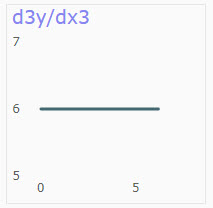The measure has to be differentiable (smooth and continuous).



When differentiating the equation of the form y = x^3, note how the third derivative is not exact. This is something to be aware of in numerical analysis. Power BI’s default y axis range selection emphasises imprecision. Setting the y axis range to 5 to 7 shows how the imprecision is actually quite small.

DAX
The DAX for dy/dx is given below. In place of [y], substitute the name of the measure you want to differentiate.
If you want to take the second derivative of [y], first create a measure [dy/dx] and then use it as the “[y]” in a new measure [d2y/dx2]. If you are calculating a 2nd or higher order derivative you need to change the value of k – it should equal your order of differentiation.
dy/dx =
/*
The task is to differentiate measure [y] with respect to x.
- Assume consecutive points on the x axis are equidistant.
- Assume [y] is differentiable (smooth and continuous).
Let
- the current point be (xn, yn).
- the point to its left be (xl, yl).
- the point to its right be (xr, yr).
The rate of change at (xn,yn) will be calculated as:
dy/dx = ( yr - yl ) / ( xr - xl )
At the edges of x's domain either xl or xr won't exist.
At the edges, blank will be returned for dy/dx.
*/
//Order of derivative
VAR k = 1
/*
You may be taking the derivative of a derivative.
That's to say [y] may already be a derivative.
You need k points either side of a point to take its kth derivative.
Near the edge of x's domain you won't have k points either side.
So,
- Find the domain of x
- Check if you're near the edge.
If you're near the edge you will end up returning blank for the derivative.
*/
//Find the domain of x.
VAR xDomain = ALL( Data[x] )
VAR NearEdgeOfDomain =
IF(
COUNTROWS( WINDOW(-k,REL,+k,xDomain) ) - 1 < 2 * k,
true,
false
)
//Find (xl, yl) and (xr, yr)
VAR xl =
CALCULATE( SELECTEDVALUE(Data[x]), OFFSET(-1,xDomain) )
var xr =
CALCULATE( SELECTEDVALUE(Data[x]), OFFSET(+1,xDomain) )
VAR yl =
CALCULATE( [y], OFFSET(-1,xDomain) )
VAR yr =
CALCULATE( [y], OFFSET(+1,xDomain) )
VAR dydx =
IF(
NearEdgeOfDomain,
BLANK(),
DIVIDE(
yr - yl,
xr - xl
)
)
RETURN dydxReferences
Introducing DAX window functions (part 1) by Jeffrey Wang